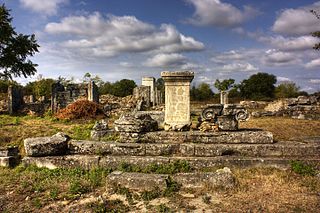|
Elagabalus - Roman Emperor: 218-222 A.D. -
Bronze 16mm (3.3 grams) from the Roman provincial city of Nicopolis in Moesia
Inferior 218-222 A.D.
AVT K M AVP ANTΩNINOC, Laureate head right.
ΝΙΚΟΠΟΛΙΤΩΝ ΠΡΟСΙСTPΩ, bunch of grapes.
You are bidding on the exact
item pictured, provided with a Certificate of Authenticity and Lifetime
Guarantee of Authenticity.
Nicopolis ad Istrum was a
Roman
and Early
Byzantine town founded by Emperor
Trajan around
101–106, at the junction of the Iatrus (Yantra)
and the Rositsa
rivers, in memory of his victory over the
Dacians. Its
ruins are located at the village of
Nikyup, 20 km north of
Veliko Tarnovo in northern
Bulgaria.
The town reached its apogee during the reigns of Trajan,
Hadrian, the
Antonines and the
Severan dynasty.

The classical town was planned according to the orthogonal system. The
network of streets, the forum surrounded by an Ionic colonnade and many
buildings, a two-nave room later turned into a basilica and other public
buildings have been uncovered. The rich architectures and sculptures show a
similarity with those of the ancient towns in Asia Minor. Nicopolis ad Istrum
had issued coins, bearing images of its own public buildings.[1]
In
447 AD, the town was destroyed by
Attila's Huns.[2]
Perhaps it was already abandoned before the early 400s.[3]
In the 6th century, it was rebuilt as a powerful fortress enclosing little more
than military buildings and churches, following a very common trend for the
cities of that century in the Danube area.[4]
The largest area of the extensive ruins (21.55 hectares) of the classical
Nicopolis was not reoccupied since the fort covered only one fourth of it (5.75
hectares), in the southeastern corner.[5]
The town became an episcopal centre during the early Byzantine period. It was
finally destroyed by the Avar invasions at the end of the 6th century. A
Bulgarian medieval settlement arose upon its ruins later (10th-14th century).[1]
Nicopolis ad Istrum can be said to have been the birthplace of
Germanic literary tradition. In the 4th century, the
Gothic bishop,
missionary and translator
Ulfilas (Wulfila)
obtained permission from Emperor
Constantius II to immigrate with his flock of converts to Moesia and settle
near Nicopolis ad Istrum in 347-8.[6]
There, he invented the
Gothic alphabet and translated the
Bible from
Greek to
Gothic.
Elagabalus
(pronounced El-uh-GAB-uh-lus, c. 203 – March 11, 222), also known as
Heliogabalus or Marcus
_-_Musei_capitolini_-_Foto_Giovanni_Dall'Orto_-_15-08-2000_.jpg/240px-Elagabalo_(203_o_204-222_d.C)_-_Musei_capitolini_-_Foto_Giovanni_Dall'Orto_-_15-08-2000_.jpg) Aurelius Antoninus, was a
Roman
Emperor of the
Severan dynasty who reigned from 218 to 222. Born Varius Avitus Bassianus,
he was
Syrian on his mother's side, the son of
Julia Soaemias and
Sextus Varius Marcellus, and in his early youth he served as a priest of the
god
El-Gabal at his hometown,
Emesa. Upon becoming emperor he took the name Marcus Aurelius Antoninus
Augustus, and was called Elagabalus only a long time after his death. Aurelius Antoninus, was a
Roman
Emperor of the
Severan dynasty who reigned from 218 to 222. Born Varius Avitus Bassianus,
he was
Syrian on his mother's side, the son of
Julia Soaemias and
Sextus Varius Marcellus, and in his early youth he served as a priest of the
god
El-Gabal at his hometown,
Emesa. Upon becoming emperor he took the name Marcus Aurelius Antoninus
Augustus, and was called Elagabalus only a long time after his death.
In 217,
the emperor
Caracalla was murdered and replaced by his
Praetorian prefect, Marcus Opellius
Macrinus.
Caracalla's maternal aunt,
Julia
Maesa, successfully instigated a revolt among the
Third Legion to have her eldest grandson, Elagabalus, declared as emperor in
his place. Macrinus was defeated on June 8, 218, at the
Battle of Antioch, upon which Elagabalus, barely fourteen years old,
ascended to the imperial power and began a reign that was marred by infamous
controversies, to put it mildly.
During his rule, Elagabalus showed a disregard for Roman religious traditions
and sexual taboos. He was married as many as five times and is reported to have
prostituted himself in the imperial palace. Elagabalus replaced
Jupiter, head of the
Roman pantheon, with a new god,
Deus
Sol Invictus, and forced leading members of Rome's government to
participate in religious rites celebrating this deity, which he personally led.
Amidst growing opposition, Elagabalus, only 18 years old, was assassinated
and replaced by his cousin
Alexander Severus on March 11, 222, in a plot formed by his grandmother,
Julia Maesa, and members of the
Praetorian Guard. Elagabalus developed a reputation among his contemporaries
for eccentricity, decadence, and zealotry which was likely exaggerated by his
successors and political rivals.[1]
This propaganda was passed on and, as a result, he was one of the most reviled
Roman emperors to early historians. For example,
Edward Gibbon wrote that Elagabalus "abandoned himself to the grossest
pleasures and ungoverned fury."[2]
"The name Elagabalus is branded in history above all others" because of his
"unspeakably disgusting life," wrote
B.G. Niebuhr.[3]
|